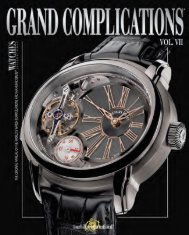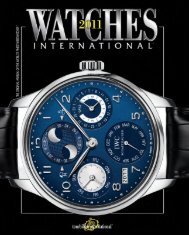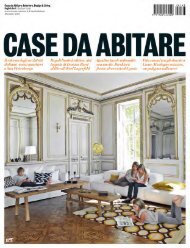180 YEARS OF
180 YEARS OF
180 YEARS OF
You also want an ePaper? Increase the reach of your titles
YUMPU automatically turns print PDFs into web optimized ePapers that Google loves.
1942<br />
Chronograph with<br />
Hour Counter<br />
CALIBER 13ZN<br />
Good is the enemy of better,<br />
and nowhere is this adage<br />
more true than when it’s<br />
applied to Longines’s movements.<br />
In 1936, the company<br />
began development of a new<br />
model to follow in the footsteps<br />
of chronograph Caliber<br />
13.33, which after 23 years in<br />
production was still successful<br />
but had become too expensive.<br />
Various devices for Caliber<br />
13ZN had already been<br />
completed by the autumn of<br />
1935, so models containing<br />
the new movement could be<br />
launched at the peak of the<br />
chronograph’s popularity. A<br />
great advantage for Longines<br />
80 | WatchTime LONGINES SPECIAL<br />
was that only a few of the<br />
brand’s competitors had manufacture<br />
calibers of this type at<br />
their disposal. Available with<br />
either one push-piece or two,<br />
Caliber 13ZN was six millimeters<br />
thick and had a fly-back<br />
mechanism, a column wheel,<br />
as well as a screw balance with<br />
a self-compensating Breguet<br />
hairspring that oscillated at a<br />
pace of 2.5 hertz, and a 30minute<br />
counter that advanced<br />
at half-minute intervals. Hourcounters<br />
became fashionable<br />
in the early 1940s, so Lon -<br />
gines’s technicians created a<br />
modified version of Caliber<br />
13ZN, first marketed in 1942,<br />
which had its 12-hour counter<br />
at 3 o’clock. Longines also<br />
enhanced the legibility of the<br />
60-minute counter by repositioning<br />
it in the dial’s center.<br />
Like its forebear, this movement<br />
was, unfortunately, too<br />
expensive, so Longines soon<br />
began developing a successor:<br />
Caliber 30CH celebrated its<br />
premiere as the brand’s last<br />
chronograph movement for<br />
wristwatches in 1947.<br />
1945<br />
First Automatic<br />
CALIBER 22A<br />
ere were very few rotor-wound calibers for wristwatches<br />
in the 1940s. To avoid infringing on patent<br />
protection, many watch brands hurriedly created hammer-wound<br />
movements with buers to brake the rotors,<br />
but Longines opted not to pursue this route. Instead, the<br />
company concentrated on a mechanism with an oscillating<br />
weight that could swing freely. Of course, Longines,<br />
too, had to contend with the obstacles presented by<br />
Swiss patent law. e way to overcome them was with a<br />
system in which the rotor wound the mainspring in both<br />
directions of rotation. is bidirectional automatic<br />
winding system was integrated in Caliber 22A: launched<br />
in 1945, it had an indirect central seconds hand and<br />
amassed 36 hours of power reserve. Its geometry is<br />
essentially based on Caliber 27, which debuted in 1944.<br />
To achieve an acceptable overall size for Caliber 22A,<br />
Longines had to miniaturize the basis, onto which the<br />
brand mounted the self-winding subassembly with a<br />
patented click changer. Right from the start, the watchmakers<br />
had detected a potential weakness: the relatively<br />
thin sta on which the oscillating weight was borne.<br />
To counteract possible breakage, a heavy metal segment<br />
was elastically axed to the central rotor’s disk. e entire<br />
device couldn’t be very at, but an overall height of<br />
5.65 millimeters was feasible, and acceptable at the time.<br />
WWW.WATCHTIME.COM

















